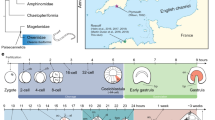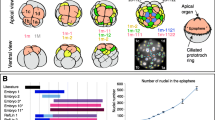Abstract
The appendicularian, Oikopleura dioica is a chordate. Its life cycle is extremely short—approximately 5 days—and its tadpole shape with a beating tail is retained throughout entire life. The tadpole hatches after 3 h of development at 20°C. Here, we describe the cleavage pattern and morphogenetic cell movements during gastrulation and neurulation. Cleavage showed an invariant pattern. It is basically bilateral but also shows various minor left–right asymmetries starting from the four-cell stage. We observed two rounds of unequal cleavage of the posterior-vegetal B-line cells at the posterior pole. The nature of the unequal cleavages is reminiscent of those in ascidian embryos and suggests the presence of a centrosome-attracting body, a special subcellular structure at the posterior pole. The representation of the cell division pattern in this report will aid the identification of each cell, a prerequisite for clarifying the gene expression patterns in early embryos. Gastrulation started as early as the 32-cell stage and progressed in three phases. By the end of the second phase at the 64-cell stage, every vegetal cell had ingressed into the embryo, and animal cells had covered the entire embryo by epiboly. There was no archenteron formation. In the anterior region, eight A-line cells were aligned as a 2 × 4 array along the anterior–posterior axis and become internalized during the 64-cell stage. This process was considered to correspond to neurulation. The simple and accelerated development of Oikopleura, nevertheless giving rise to a conserved chordate body plan, is advantageous for studying developmental mechanisms using molecular and genetic approaches and makes this animal the simplest model organism in the phylum Chordata.






Similar content being viewed by others
References
Bassham S, Postlethwait J (2000) Brachyury (T) expression in embryos of a larvacean Urochordata, Oikopleura dioica, and the ancestral role of T. Dev Biol 220:322–332
Bourlat SJ, Juliusdottir T, Lowe CJ, Freeman R, Aronowicz J, Kirschner M, Lander ES, Thorndyke M, Nakano H, Kohn AB, Heyland A, Moroz LL, Copley RR, Telford MJ (2006) Deuterostome phylogeny reveals monophyletic chordates and the new phylum Xenoturbellida. Nature 444:85–88
Burighel P, Brena C, Martinucci B, Cima F (2001) Gut ultrastructure of the appendicularian Oikopleura dioica (Tunicata). Invertebrate Biol 120:278–293
Cañestro C, Postlethwait JH (2007) Development of a chordate anterior–posterior axis without classical retinoic acid signaling. Dev Biol 305:522–538
Chioda M, Eskeland R, Thompson EM (2002) Histone–gene complement, variant expression, and mRNA processing in a Urochordate Oikopleura dioica that undergo extensive polyploidization. Mol Biol Evol 19:2247–2260
Conklin EG (1905) The organization and cell lineage of the ascidian egg. J Acad Nat Sci (Philadelphia) 13:1–119
Delsman HC (1910) Beiträge zur Entwicklungsgeschichte von Oikopleura dioica. Verh Rijksinst Onderz Zee 3:3–24
Delsuc F, Brinkmann H, Chourrout D, Philippe H (2006) Tunicates and not cephalochordates are the closest living relatives of vertebrates. Nature 439:965–968
Fenaux R (1998a) Anatomy and functional morphology of the Appendicularia. In: Bone Q (ed) The biology of pelagic tunicates. Oxford University Press, New York, pp 25–34
Fenaux R (1998b) Life history of the Appendicularia. In: Bone Q (ed) The biology of pelagic tunicates. Oxford University Press, New York, pp 151–159
Ganot P, Kalleosoe T, Thompson EM (2007) Cytoskeleton organized germ nuclei with divergent fates and asymchronous cycles in a common cytoplasm during oogenesis in the chordate Oikopleura. Dev Biol 302:577–590
Hibino T, Nishikata T, Nishida H (1998) Centrosome-attracting body: A novel structure closely related to unequal cleavages in the ascidian embryo. Dev Growth Differ 40:85–95
Imai KS, Levine M, Satoh N, Satou U (2006) Regulatory blueprint for a chordate embryo. Science 312:1183–1187
Iseto T, Nishida H (1999) Ultrastructural studies on the centrosome-attracting body: Electron-dense matrix and its role in unequal cleavage in ascidian embryos. Dev Growth Differ 41:601–609
Lee JY, Marston DJ, Walston T, Hardin J, Halberstadt A, Goldstein B (2006) Wnt/Frizzled signaling controls C. elegans gastrulation by activating actomyosin contractility. Curr Biol 16:1986–1997
Munro EM, Odell GM (2002) Polarized basolateral cell motility underlies invagination and convergent extension of the ascidian notochord. Development 129:13–24
Negishi T, Takada T, Kawai N, Nishida H (2007) Localized PEM mRNA and protein are involved in cleavage-plane orientation and unequal cell divisions in ascidians. Cur Biol 17:1014–1025
Nishida H (1987) Cell lineage analysis in ascidian embryos by intracellular injection of a tracer enzyme. III. Up to the tissue restricted stage. Dev Biol 121:526–541
Nishida H (2002) Specification of developmental fates in ascidian embryos: molecular approach to maternal determinants and signaling molecules. Int Rev Cytol 217:227–276
Nishida H (2005) Specification of embryonic axis and mosaic development in ascidians. Dev Dynam 233:1177–1193
Nishida H, Morokuma J, Nishikata T (1999) Maternal cytoplasmic factors for generation of unique cleavage patterns in animal embryos. Cur Topics Dev Biol 46:1–37
Nishikata T, Hibino T, Nishida H (1999) The centrosome-attracting body, microtubule system, and posterior egg cytoplasm are involved in positioning of cleavage planes in the ascidian embryo. Dev Biol 209:72–85
Nishino A, Satoh N (2001) The simple tail of chordates: Phylogenetic significance of appendicularians. Genesis 29:36–45
Nishino A, Satou Y, Morisawa M, Satoh N (2000) Muscle actin genes and muscle cells in the appendicularian, Oikopleura longicauda: Phylogenetic relationships among muscle tissues in the urochordates. J Exp Zool (Mol Dev Evol) 288:135–150
Nishino A, Satou Y, Morisawa M, Satoh N (2001) Brachyury (T) gene expression and notochord development in Oikopleura longicauda (Appendicularia, Urochordata). Dev Genes Evol 211:219–231
Seo HC, Kube M, Edvardsen RB, Jensen MF, Jensen MF, Beck A, Spriet E, Gorsky G, Thompson E, Lehrach H, Reinhardt R, Chourrout D (2001) Miniature–genome in the marine chordate Oikopleura dioica. Science 294:2506
Seo HC, Edvardsen RB, Maeland AD, Bjordal M, Jensen MF, Hansen A, Flaat M, Weissenbach J, Lehrach H, Wincker P, Reinhardt R, Chourrout D (2004) Hox cluster disintegration with persistent anteroposterior order of expression in Oikopleura dioica. Nature 431:67–71
Shirae-Kurabayashi M, Nishikata T, Takamura K, Tanaka K, Nakamoto C, Nakamura A (2006) Dynamic redistribution of vasa homolog and exclusion of somatic cell determinants during germ cell specification in Ciona intestinalis. Development 133:2683–2693
Stach T, Turbeville JM (2005) The role of appendicularians in chordate evolution—a phylogenetic analysis of molecular and morphological characters, with remarks on ‘neoteny-scenarios’. In: Gorsky G, Youngbluth MJ, Deibel D (eds) Response of Marine Ecosystem to Global Change: Ecological Impact of Appendicularians. Contemporary, Paris, pp 9–26
Stern CD (2004) Gastrulation: From Cell to Embryo. Cold Spring Harbor Laboratory Press, New York
Sulston JE, Schierenberg E, White J, Thomson JN (1893) The embryonic cell lineage of the nematode Caenorhbditis elegans. Dev Biol 100:64–119
Swalla BJ, Cameron CB, Corley LS, Garey JR (2000) Urochordates are monophyletic within the deuterostomes. Syst Biol 49:52–64
Thompson EM, Kallesoe T, Spada F (2001) Diverse–genes expressed in distinct regions of the trunk epithelium define a monolayer cellular template for construction of Oikopleurid house. Dev Biol 238:260–273
Tomioka M, Miya T, Nishida H (2002) Repression of zygotic gene expression in the putative–germline cells in ascidian embryos. Zool Sci 19:49–55
Acknowledgments
We thank Dr. D. Chourrout for inviting HN to their lab and teaching us how to culture Oikopleura. Thanks are also due to the members of the Misaki Marine Biological Station and the Seto Marine Biological Laboratory for help in collecting Oikopleura to start our culture. We are grateful to Dr. T. Stach and his colleagues for sharing their unpublished results. We also thank Dr. A. Nishino (Osaka University) for critical reading of the manuscript. This work was supported by Grants in Aid from Ministry of Education, Culture, Sports, Science and Technology (17657073).
Author information
Authors and Affiliations
Corresponding author
Additional information
Communicated by N. Satoh
Electronic supplementary material
Below is the link to the electronic supplementary material:
Supplemental Movie S1
Embryogenesis of Oikopleura dioica, from egg to tadpole larva. Larvae hatched at 6 h of development at 13°C. (MOV 6.30 KB)
Supplemental Movie S2
Two rounds of unequal cell division of B-line blastomeres at the posterior pole; the vegetal pole is at the upper left. Posterior view, the video starts at the eight-cell stage and ends during gastrulation. The B blastomere pair of the eight-cell embryo divides unequally twice–generating the smaller B1 of the 16-cell embryo and B11 of the 32-cell embryo. (AVI 4.42 KB)
Supplemental Movie S3
Gastrulation movements, vegetal view; anterior is up. The video starts at the four-cell stage and finishes at the end of the second phase of gastrulation. Neurulation is also visible in the anterior region. This video corresponds to Fig. 4. (MOV 449 KB)
Supplemental Movie S4
Neurulation; anterior is at bottom left. Vegetal pole is at the upper right. Four cells of A1 descendants in the anterior region divide once along the anterior–posterior axis and are then internalized. This video corresponds to Fig. 6. (AVI 1.83 KB)
Rights and permissions
About this article
Cite this article
Fujii, S., Nishio, T. & Nishida, H. Cleavage pattern, gastrulation, and neurulation in the appendicularian, Oikopleura dioica . Dev Genes Evol 218, 69–79 (2008). https://doi.org/10.1007/s00427-008-0205-4
Received:
Accepted:
Published:
Issue Date:
DOI: https://doi.org/10.1007/s00427-008-0205-4




